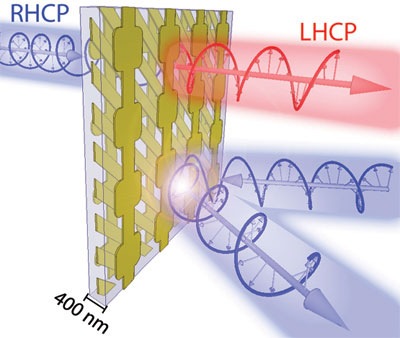Shrinking the size of optical systems, exponentially
The researchers believe that metasurfaces could one day be used to completely control the phase, amplitude, and polarization of light.

 Enlarge
Enlarge
Researchers have developed a way to exponentially shrink the size of a system typically needed to control the polarization of light, while maintaining the high level of performance needed for numerous optical applications such as color displays, microscopy and photography.
Circular polarizers play a vital role in many of these optical systems, yet typically rely on bulky optical setups made up of millimeter-sized lenses, crystals, and polarizers. By using ultra-thin metamaterials called metasurfaces, all of that optical equipment is replaced with a metasurface that measures 250 μm x 250 μm, and 400nm thick.
This is not the first time metasurfaces have been employed for optical systems, but it is the first time researchers have detailed a method for their design and fabrication that results in a device having more than 50% efficiency.
“The performance of our metasurfaces is more than sufficient for many applications that require optical elements with very small form factors,” said doctoral researcher Carl Pfeiffer, “such as lab-on-a-chip, pocket cameras, and biomedical optics.”
Mr. Pfeiffer is lead author on the paper detailing the device, High Performance Bianisotropic Metasurfaces: Asymmetric Transmission of Light, co-authored by Cheng Zhang, Vishva Ray, Prof. L. Jay Guo, and his advisor, Prof. Anthony Grbic, and published in Physical Review Letters.
The researchers designed and fabricated a metasurface that is composed of three patterned gold sheets separated by dielectric substrates; the layers are spaced at a subwavelength scale. Each sheet was fabricated by patterning a 2nm Ti adhesion layer and 28nm Au layer using e-beam lithography.

 Enlarge
Enlarge
Right-handed circularly polarized (RHCP) light enters the front of the metasurface, and emerges from the opposite side as left-handed-circularly polarized (LHCP) light. However, when LHCP light enters the front, only 2.5% of the light is transmitted. This effectively polarizes the light. At the operating optical wavelength of 1.5 μm, the transmittance from RHCP to LHCP is 50%.
“In the future, larger areas can be fabricated using methods such as nano-imprinting, which has been developed for years in Prof. Jay Guo’s lab,” said doctoral researcher Cheng Zhang. Cheng fabricated the device in the Lurie Nanofabrication Facility.
The researchers believe that metasurfaces could one day be used to completely control the phase and amplitude, as well as the polarization, of light, which will further extend their usefulness.
“One day,” said Carl, “we believe that we will be able to replace the optical components that are currently used in analytic chemistry, biology, and crystallography to identify the spatial structures of molecules, with our ultrathin metasurfaces. These metasurfaces could also be used in applications such as infrared identifiers, which utilize the unique polarization signature emitted by an infrared ID tag in a similar way that newer credit card readers use near field communication to read a credit card without swiping it.”
The research was supported in part by the NSF Materials Research Science and Engineering Center for Photonic and Multiscale Nanomaterials (C-PHOM) and the Air Force Research Laboratory.
 MENU
MENU 
